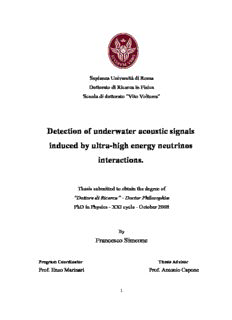
Detection of underwater acoustic signals induced by ultra-high energy neutrinos interactions. PDF
Preview Detection of underwater acoustic signals induced by ultra-high energy neutrinos interactions.
Sapienza Università di Roma Dottorato di Ricerca in Fisica Scuola di dottorato ”Vito Volterra” Detection of underwater acoustic signals induced by ultra-high energy neutrinos interactions. Thesis submitted to obtain the degree of ”Dottore di Ricerca” - Doctor Philosophiæ PhD in Physics - XXI cycle - October 2008 By Francesco Simeone Program Coordinator Thesis Advisor Prof. Enzo Marinari Prof. Antonio Capone 1 2 Contents List of figures _________________________________________________________5 1. Introduction_______________________________________________________9 1.1. Motivation for neutrino astrophysics___________________________________ 9 1.2. Sources of ultra high energy neutrinos ________________________________ 12 2. Detection of ultra high energy neutrinos_______________________________15 2.1. Water Cherenkov detectors _________________________________________ 15 2.2. Radio Cherenkov detectors__________________________________________ 16 2.3. Extensive Air shower detectors ______________________________________ 18 2.4. Acoustic detectors _________________________________________________ 20 2.5. Present limits on the neutrino flux____________________________________ 21 3. Neutrino interactions in water _______________________________________23 3.1. Thermo-acoustic model_____________________________________________ 23 3.2. Experimental proof of the thermo-acoustic model_______________________ 26 3.3. High energy showers in water _______________________________________ 28 3.4. Present results of acoustic signal simulation____________________________ 34 4. Underwater environment ___________________________________________39 4.1. Sound velocity in water_____________________________________________ 39 4.2. Sound attenuation _________________________________________________ 41 4.3. Sound propagation ________________________________________________ 44 4.4. Ray tracing technique______________________________________________ 51 5. Sound detection___________________________________________________57 5.1. Hydrophones transducer____________________________________________ 57 5.2. Equivalent hydrophones noise _______________________________________ 58 5.3. Underwater noise__________________________________________________ 61 6. Detection algorithm _______________________________________________69 6.1. Strategy outlook___________________________________________________ 69 6.2. Approach for the single hydrophone__________________________________ 69 6.3. Approach for array of hydrophones __________________________________ 70 7. Matched filter ____________________________________________________71 7.1. Optimal linear filter________________________________________________ 71 7.2. Simulation results _________________________________________________ 76 7.3. Practical consideration _____________________________________________ 80 3 8. Beam-Forming ___________________________________________________83 8.1. Delay and sum Beam-Forming_______________________________________ 83 8.2. Array response function ____________________________________________ 85 8.3. Phased array _____________________________________________________ 86 8.4. Uniform Linear Array______________________________________________ 88 8.5. Array gain versus noise_____________________________________________ 93 8.6. Simulation results _________________________________________________ 96 9. Detector simulations______________________________________________103 9.1. Detector geometry________________________________________________ 103 9.2. Events generation_________________________________________________ 104 9.3. Signal propagation________________________________________________ 106 9.4. Signal detection __________________________________________________ 107 9.5. Reconstruction___________________________________________________ 109 9.6. Simulation results ________________________________________________ 114 9.7. Expected event rate for GZK neutrinos ______________________________ 117 Bibliography ________________________________________________________120 Acknowledgements ___________________________________________________122 4 List of figures Figure 1.1 ___________________________________________________________10 Figure 1.2 ___________________________________________________________11 Figure 1.3 ___________________________________________________________13 Figure 1.4 ___________________________________________________________14 Figure 2.1 ___________________________________________________________17 Figure 2.2 ___________________________________________________________18 Figure 2.3 ___________________________________________________________19 Figure 2.4 ___________________________________________________________20 Figure 2.5 ___________________________________________________________22 Figure 3.1 ___________________________________________________________24 Figure 3.2 ___________________________________________________________26 Figure 3.3 ___________________________________________________________27 Figure 3.4 ___________________________________________________________28 Figure 3.5 ___________________________________________________________29 Figure 3.6 ___________________________________________________________31 Figure 3.7 ___________________________________________________________33 Figure 3.8 ___________________________________________________________34 Figure 3.9 ___________________________________________________________35 Figure 3.10 __________________________________________________________36 Figure 3.11 __________________________________________________________37 Figure 3.12 __________________________________________________________38 Figure 4.1 ___________________________________________________________41 Figure 4.2 ___________________________________________________________43 Figure 4.3 ___________________________________________________________44 Figure 4.4 ___________________________________________________________48 Figure 4.5 ___________________________________________________________52 Figure 4.6 ___________________________________________________________53 Figure 5.1 ___________________________________________________________58 Figure 5.2 ___________________________________________________________58 5 Figure 5.3 ___________________________________________________________60 Figure 5.4 ___________________________________________________________62 Figure 5.5 ___________________________________________________________63 Figure 5.6 ___________________________________________________________64 Figure 5.7 ___________________________________________________________65 Figure 5.8 ___________________________________________________________67 Figure 5.9 ___________________________________________________________68 Figure 7.1 ___________________________________________________________71 Figure 7.2 ___________________________________________________________73 Figure 7.3 ___________________________________________________________76 Figure 7.4 ___________________________________________________________77 Figure 7.5 ___________________________________________________________79 Figure 7.6 ___________________________________________________________79 Figure 7.7 ___________________________________________________________81 Figure 8.1 ___________________________________________________________87 Figure 8.2 ___________________________________________________________87 Figure 8.3 ___________________________________________________________88 Figure 8.4 ___________________________________________________________91 Figure 8.5 ___________________________________________________________92 Figure 8.6 ___________________________________________________________98 Figure 8.7 ___________________________________________________________98 Figure 8.8 ___________________________________________________________99 Figure 8.9 ___________________________________________________________99 Figure 8.10 _________________________________________________________101 Figure 8.11 _________________________________________________________102 Figure 9.1 __________________________________________________________104 Figure 9.2 __________________________________________________________105 Figure 9.3 __________________________________________________________105 Figure 9.4 __________________________________________________________106 Figure 9.5 __________________________________________________________108 Figure 9.6 __________________________________________________________110 Figure 9.7 __________________________________________________________111 6 Figure 9.8 __________________________________________________________112 Figure 9.9 __________________________________________________________112 Figure 9.10 _________________________________________________________113 Figure 9.11 _________________________________________________________115 Figure 9.12 _________________________________________________________116 Figure 9.13 _________________________________________________________118 7 8 1. Introduction In this chapter the motivation of the neutrino astrophysics are discussed and the possible sources of high energy neutrinos are reviewed. 1.1. Motivation for neutrino astrophysics Almost everything we know about the Universe came from its observation by means of electromagnetic radiation. Using the photons as observation probe it has been possible to discover very energetic sources, however the photons are highly absorbed by matter and so their observation only allows to directly obtain information of the surface process at the source. Moreover energetic photons interact with the photon background (microwave, infrared and radio) and are attenuated during their travel from the source toward us (the GZK effect[1][2]). The main reaction that take place is: γ+γ →e− +e+ (1.1) CMBR assuming a temperature of the cosmic microwave background(CMBR) equal to 2.73K (mean energy ~6.5*10-4eV) the cinematic threshold is equal to E ≈104m2 14≈ 2⋅1014eV . This effect reduces the mean free path of a 1015eV photon γ e to about 10kpc and make impossible to study extra galactic sources using photons. Observation of the proton component of the cosmic rays can give informations about the sources but, since they are charged, low energy protons are deflected by the magnetic galactic fields and loose the directional information that would allow us to point back to their source. High energy protons are slightly deflected by magnetic fields and in principle could be good probe for the high energy Universe. Unfortunately, as pointed out by Greisen-Zatsepin-Kuz’min[1][2], the proton interactions with the CMBR will reduce the proton energy, for instance, by resonant pion production: 9 N +γ → N +π (1.2) CMBR The kinematic threshold for this reaction is about 5*1019eV. This prevent the observation of protons with energy above 1020eV coming from sources more distant that about 30Mpc. In figure 1.1 the attenuation length due to different interactions of protons and photons with the photon background is reported. Figure 1.1 The attenuation length of p and γ with the photon background (IR, CMBR and radio) as a function of the incident particle. In order to directly observe the inner physical mechanism of distant and energetic sources we need to use a neutral, stable and weakly interacting messenger: the neutrino. The interest in studying such high energy sources arises from the fact that much of the classical astronomy is related to the study of the thermal radiation, emitted by stars or dust, while the non thermal energy density in the Universe is roughly equal the thermal one and is assumed to play a relevant role in its evolution. The presence of such non thermal Universe is confirmed by the cosmic ray spectrum reported in figure 1.2. 10
Description: